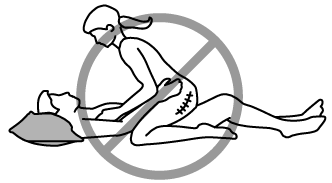Ask your surgeon about any sports or other activities you want to do. The following are
only guidelines for what you may or may not do.
Movements to Avoid
Bending

- Do not bend your hip more than 90°.
- Do not bring your knee higher than your hip.
- Do not reach forward towards your feet.
- Do not reach down for objects on the floor.
Twisting and Turning
Don’t:
- twist your operated leg when
standing,
sitting, or
lying down
- twist your leg when turning
Do:
-
take small steps while turning
- keep your toes facing the same direction
Crossing Your Legs
Don’t:
- bring your leg across the mid-line of your body
- cross your legs at the knee or ankle when sitting, standing, or lying down
Do:
-
sit up straight with your back touching the back of the chair
Sleeping
You can sleep on either side, but you
must always have pillows between your legs to prevent them from crossing.
If you
sleep on your back, don’t put a pillow under the knee of your operated leg. It can cause a blood clot to form. It can also cause a permanent bend in your knee.
Sexual Positions
Many people have questions about intimate relations after a hip replacement.
While it’s usually safe for your hip joint about 4 to 6 weeks after surgery, you also have to feel ready and be comfortable.
For the first 3 months, you have to protect the new joint. This brochure shows you the positions that are safe and the ones that aren’t safe for your new joint.
- Make sure you let your partner know what’s comfortable or if a position causes pain.
- Make sure you’re comfortable before you start. Using pillows may help.
- No sudden movements.
- Make sure your partner doesn’t put their full weight on your hips if you had a hip replacement.
Safe Positions for the Hip Joint
Positions Not Safe for the Hip Joint

Hip twists too much.

Hip bends too much.

Hip bends and twists too much.

Hip bends too much.
*Illustrations from Returning to Sexual Activity following Joint Replacement Surgery (Vancouver Coastal Health, 2013) and Sex after Joint Replacement Surgery (London Health Sciences Centre, 2013)
General Guidelines
The First 3 Months after Surgery
- Walking
- Phase 1 exercises
- Phase 2 exercises – start when your Case Manager or physiotherapist tells you to.
After 3 Months
- Swimming and other pool exercises: Careful not to do any twisting motions such as a whip kick.
- Low-impact fitness exercises that
don’t involve jumping, twisting, quick starts or stops, or other movements that put sudden force on your hip.
- Walking on a treadmill.
- Golfing.
- Cycling: The seat and handlebars must be set high enough so that you don’t have to bend your hip more than 90°.
- Slow, gentle dancing.
- Light hiking.
- Gardening: Use raised beds or long-handled tools so that you don’t have to bend your hip more than 90°.
Activities NOT to Do
- Do not lift and push heavy objects (25 lbs. or 11 kg).
- Do not do any activities involving jumping, twisting, quick starts or stops, or other movements that put sudden force on your hip.
- Do not do contact sports.
